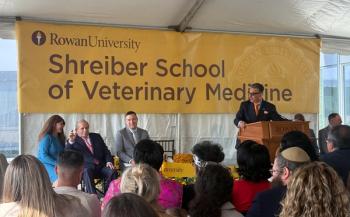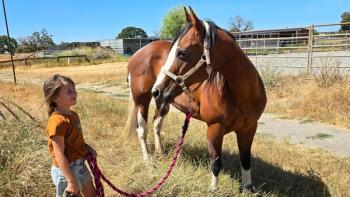
Equine neonatal sepsis: causes, consequences, diagnosis (Proceedings)
Bacterial septicemia is the leading cause of morbidity and mortality in equine neonates. Survival rates reported over the last 5 years in retrospective studies of septicemic foals are highly variable, ranging between 40 and 70%, and comparisons among studies are difficult because of differences in case definition.
Background:
Bacterial septicemia is the leading cause of morbidity and mortality in equine neonates. Survival rates reported over the last 5 years in retrospective studies of septicemic foals are highly variable, ranging between 40 and 70%, and comparisons among studies are difficult because of differences in case definition. Septicemia is a presumptive diagnosis, based upon the overall clinical impression gained from a combination of clinical variables, and for neonatal foals the sepsis score system described by Brewer often is used. In contrast, the diagnosis of bacteremia requires identification of the etiologic agent by bacteriologic culture of blood and is independent of the severity of the resulting illness. The most common etiologic agents isolated from bacteremic foals are Gram-negative enteric bacteria, such as Enterobacteriaceae, and Actinobacillus sp. Escherichia coli is generally the most frequently isolated organism from the blood of bacteremic equine neonates, with Actinobacillus sp. often identified as the second most common isolate.
Survival rates reported in previous retrospective studies of septicemic foals are variable. Gayle reported a survival rate of 45% (29/65), Raisis 70% (17/24), Brewer 45% (29/65), Koterba 26% (10/38), Hoffman, 10%and Stewart 54% (55/101). Comparisons are difficult due to differences in case definitions, ages of the foals, financial situations of owners and management strategies available at clinics in different geographic locations.
The most common organisms cutured from the blood of foals are: E.coli Actinobacillus sp. Enterococcus sp., Enterobacter sp, Klebsiella sp, Streptococcus sp, with few cases of Salmonella sp, Staphylococcus sp, Pseudomonas sp, Proteus Sp and Anerobes.
Keys to success:
• Early diagnosis
• Early and aggressive antibiotic therapy and supportive care
• Time and money!
Physical examination
Some foals show overt clinical signs of illness (dullness, anorexia, hyper or hypothermia), others require accurate and skilled observation to detect abnormalities. Observing the mare and foal (undisturbed) provides information about the foal's nursing attitude. If the foal stimulates the udder, without actually nursing, frequently spontaneous milk let down is observed. Dry milk may be noticed on the mare's hind limbs, or on the foal's nose. A firm, dry udder with filled teats indicates that the foal is not nursing. Evaluation of the udder's content may reveal the presence of colostrum, indicating likely failure of adequate transfer of humoral immunity. The suckle reflex of the foal should also be assessed.
Oral and nasal mucous membranes, sclera, ear pinnae should be evaluated for the presence of hyperemia and petechiations. Periocular, nasal and labial skin, if non-pigmented, may appear erythematous suggesting systemic inflammatory response. Coronitis may be present if the skin over the coronary bands is non-pigmented. Ocular abnormalities in septic foals include entropion and uveitis (which may manifest with iris discoloration, hypopion, acqueous flare, vitreal hue, often in the absence of blepharospasm). Decubital ulcers and linear dermal necrosis may be noticed during the physical examination. Each joint should be palpated and compared with the controlateral one; the presence of hot, pitting limb edema may be a sign of sympathetic inflammation preceding the development of joint effusion in septic arthritis.
Auscultation is not as sensitive a diagnostic tool in foals, as it is in adult horses. While the absence of abnormal lung sounds doesn't rule out foal pneumonia, the presence of abnormal lung sounds in foals older than 1 day of age is an indicator of pulmonary disease. Signs of cardiovascular shock (prolonged capillary refill time, pale injected mucous membranes, poorly perfused distal limbs, weak pulse quality) may be present. Palpation of the external and, in compliant foals, internal umbilical remnants is part of the neonatal physical exam (use gloves!). Ultrasonographic evaluation of the umbilical structures can be performed with a 7.5-MHz transducer. Externally palpable abnormal umbilical structures are only present in 50% of foals with umbilical abscesses, therefore ultrasound examination is well worthwhile if the veterinarian has expertise in this area.
Laboratory findings
Septic foals commonly have neutropenia with a left shift and toxic neutrophilic granulocytes, but the neutrophil count can also be normal or increased. Hyperfibrinogenemia, hypoalbuminemia, hypoglycemia, metabolic acidosis and hypoxemia are other laboratory findings that are frequently, but not consistently, associated with neonatal septicemia. Indices of hemostasis and fibrinolysis (including prothrombin, activated partial thromboplastin, fibrinogen and fibrin degradation products, plasminogen and antithrombin III) are significantly changed in septic foals. The "sepsis score" is the product of the integration of multiple data concerning a sick foal. The score can be used to assess how severely ill a foal is, however, foals that have early bacteremia may not be very sick if examined early in the course of their disease. Even if the score is low, antibiotics should be administered if there is a chance of the foal being bacteremic.
Blood culture
Bacteremia is confirmed with a positive blood culture. One or more samples (separated by at least one hour interval) are easily collected by venipuncture, using sterile gloves and if possible a mask, after an area over the jugular vein is shaved and sterilely prepared. A new (sterile) needle should be used to inject the blood in the culture vial (BBL Septi-check, Becton-Dickinson). Care should be provided to avoid contamination of the culture vial injection site prior to inoculation of the blood. A positive blood culture is obtained approximately 60% of the time in septicemic foals. Previous administration of antimicrobials has little effect on the results of the culture. Blood culture results can help determine antibiotic therapies.
Failure of passive transfer (fpt)
A concentration of 400 mg/dl is the minimum recommended IgG concentration. High-risk foals should have an IgG concentration >800 mg/dl. Concentrations of IgG <200 mg/dl (total failure) should be treated as an emergency. These foals usually require 2 liters of plasma. Foals with IgG concentrations between 200 and 400 mg/dl can be given 1 liter of plasma, and blood can be drawn the following day for IgG determination. In cases where the colostrum is known to be of poor quality (specific gravity <1.060) or the mare has lost her colostrum before delivery, the foal should be given stored and tested colostrum within 12 h of birth.
Omphalophlebitis
Omphalophlebitis is predisposed by inappropriate handling of the umbilicus at delivery, an unsanitary environment or as a consequence of bacteremia. Umbilical hematomas are uncommon, but can pre-dispose to omphalophlebitis. Weak or recumbent foals are more likely to have umbilical infections because of increased exposure to bedding, dust, and/or fecal material. Dipping of the umbilicus can sometimes cause more harm than good. Iodine should be diluted ("weak tea"). We have seen some foals that have had the peri-umbilical skin and umbilicus become necrotic and infected due to over-zealous umbilical dipping. We recommend dipping the umbilicus twice daily for 3 days using 0.5% chlorhexidine or diluted povidone iodine solution. Do not handle the umbilicus without gloves. Umbilical infections are usually apparent around 3 - 4 wks of age in healthy foals, and earlier in sick foals. Some foals are febrile and have leukocytosis at presentation; however, most non-septic foals have a normal physical examination except for purulent drainage or abscess formation surrounding the umbilicus. Inapparent urachal or umbilical vein abscesses do occur, and these foals usually present with fever of unknown origin, elevated WBC count, and fibrinogen, septic arthritis or other signs of bacteremia.
Ultrasounographic examination is used to determine the severity of the infection, the structures involved, and the extent of the infection. Most abscesses are external, but many involve the internal structures and will run the entire length of the arteries, abdominal urachus, or abdominal umbilical veins. If the abscess is draining, it is cultured for bacterial identification and sensitivity. The most common bacteria isolated are beta hemolytic Streptococcus sp., E. coli. Staphylococcus or anaerobes. Surgical removal is becoming less favored, as apposed to long-term antibiotic therapy. The most commonly used antibiotics are penicillin with gentamicin or amikacin; oral doxycycline and rifampin; oral chloramphenicol or azithromycin and rifampin. Follow-up ultrasound examinations and CBCs and fibrinogen concentration are performed to determine the appropriate time to stop the therapy.
Septic arthritis and osteomyelitis
The name (Joint Ill or Navel Ill) arises from an association with umbilical infections. Current feeling is that other routes of infection (oral inoculation prior to colostrum intake) are probably a more common cause of bacteremia and secondary septic arthritis. Foals may survive severe sepsis, only to subsequently develop a septic joint during the course of therapy, or weeks to months later. Foals that become suddenly lame after 3-6 weeks generally have osteomyelitis with secondary erosion into the synovium. Severe lytic radiographic lesions are often present.
Osteomyelitis is often caused by Salmonella, Rhodococcus, or Klebsiella. Circulating bacteria, whether from the umbilicus or other areas, are shed into the blood. They then lodge and grow in the epiphyseal or metaphyseal growth complex, extending into the joint cavity. Primary synovial colonization, although possible, is less common.
Many foals that develop septic arthritis have no history or clinical signs of umbilical disease, and most had adequate IgG concentrations as newborns. Any time a foal presents with lameness and fever, septic arthritis is the first problem to rule out. Waiting for just 1 day can make a serious difference in the eventual outcome. The longer one waits to lavage the joint, the greater the cartilage damaged. Additionally, the infection seems to become more deeply seated in the bone, making treatment more extensive and costly with a poorer prognosis. Infections established in the bone quickly become hypovascular because of the exudates pressure, and, therefore, they are more difficult to penetrate with systemic antibiotics. Confirmed septic joints are lavaged, injected with amikacin and have regional perfusion performed with a 3rd generation cephalosporin (or amikacin) in addition to systemic antibiotics. The antibiotics selected for long term therapy are based on culture results and sensitivity. Non-responsive infections are frequently found to be resistant to the broad-spectrum selection.
Synovial fluid culture and analysis
Placing an infected synovial fluid sample directly onto a blood agar plate will rarely, if ever, produce a positive culture result, particularly if the sample comes from an animal already on systemic antibiotics. The best chance of obtaining a positive joint fluid culture is to collect the joint fluid (aseptically) prior to commencing systemic antibiotics and placing it (aseptically) directly into a blood culture bottle. Normal joint fluid is thick, viscous, and clear with a total WCC of < 0.5 x 109/1 (mostly monocytes). Inflammation in response to trauma or DJD may cause joint fluid to become thin and slightly discolored and to exhibit a rise in total WCC to 1-2 x 109/1 with an increase in the percent neutrophils. Joint fluids with a WCC > 5.0 x 10/9/1 with predominately neutrophils, strongly suggests sepsis. Typically, septic joints exhibit total WCC of 20-100 x 109/1, predominately neutrophils.
Gastric ulceration
Any ill foals may be predisposed to developing gastric ulceration. Gastric ulcer syndrome encompasses a variety of ulcer disease states in the neonatal foal, including silent or subclinical ulcers, clinical (active) ulcers, perforating ulcers and duodenal ulcers that result in pyloric stricture and gastric outflow obstruction. Silent ulcers are often found incidentally during gastroscopy or at post-mortem examination. Critically ill foals may display no clinical signs when ulcers are present, and may even perforate without showing preceding signs. Active ulcers occur both in the glandular and nonglandular regions of the stomach, and result in colic (dorsal recumbency), anorexia or reduced suckling, poor growth, diarrhea, bruxism, and ptyalism. Gastric retention and reflux may also be seen. Perforating ulcers result in diffuse peritonitis and high mortality. Pyloric strictures may result from duodenal ulcers as they heal. Though gastric outflow obstruction is most common in foals 3-5 months of age, it can also occur during the neonatal period.
Fecal occult blood is not a reliable diagnostic test (many false negatives) but may support the diagnosis, as may metabolic alkalosis and hypochloremia (from excessive salivation and drooling).
There has been a shift to NOT routinely administering prophylactic antiulcer medication to sick foals. A recent study found a reduced incidence of gastric rupture in sick foals with improved intensive care management and no anti-ulcer medication compared to foals that were administered antiulcer medication and treated in previous years. Early treatment of sepsis, sufficient oxygenation, improved monitoring, institution of enteral feedings and improved nursing all may contribute to reduction in clinically important gastric ulcers in the neonatal patient. Reducing gastric acid may remove a natural gastrointestinal protective barrier. A study found that recumbent critically ill foals actually had an alkaline gastric pH and therefore acid inhibiting drugs are not indicated. Treatment may be warranted for foals that have decreased oral intake or are teeth grinding, salivating or showing signs of colic.
Gastric ulcerationtreatment
Prevention of neonatal sepsis on the farm
Transient colostral absorption mechanisms of the intestinal tract (open gut) facilitates bacterial translocation across the gut into the lymphatics and blood stream. During post foaling events bacteria are ingested during udder seeking and natural sucking activities of the foal. Bacterial load in the environment, on the hair coat of the mare, the udder and contamination of fetal membranes by defecation during stage two labor bring an abundance of Gram negative and some Gram positive bacteria to areas subjected to oral contact by the newborn foal. A reduction in bacterial numbers to which the foal is exposed during this temporary period and rapid closure of the gut may prevent bacterial translocation and infection by this route.
Husbandry methods to reduce bacterial exposure during the period of the open gut
1. Keep the mare in facilities in which foaling will take place to allow production of antibodies in the mare to pathogens within the local area. Clean foaling stalls twice daily and disinfect stalls prior to use. Wash the mare daily to reduce bacterial build up on the hair coat and perineum.
2. Immediately following delivery prevent the foal from contacting the mare until the mare is washed. Use large volumes of soap and water to remove bacteria around the perineum and udder and rear quarters where the foal may contact fecal bacteria during udder seeking. Dry the mare.
3. Milk the mares' cleaned mammary gland of 2-4 oz of colostrum (preferably greater than 1.060 specific gravity) and bottle feed the foal prior to the foal rising and upon obtaining a suck reflex. Use colostrum from a colostrum bank if necessary.
4. If the foal is weak, tube feed the foal within 1 hour of birth with 6-8 oz of colostrum or if none available use mare milk replacer or if none available use cow's milk. In orphan foals continue feeding from a bottle or pan until 10% of body weight is fed.
5. In any foals without an observed birth or failure to undertake the above protocol, begin antibiotic therapy within 6-8 hrs of birth and treat for 48 to 72 hours only. Use penicillin and gentamicin or ceftiofur IM.
Newsletter
From exam room tips to practice management insights, get trusted veterinary news delivered straight to your inbox—subscribe to dvm360.






